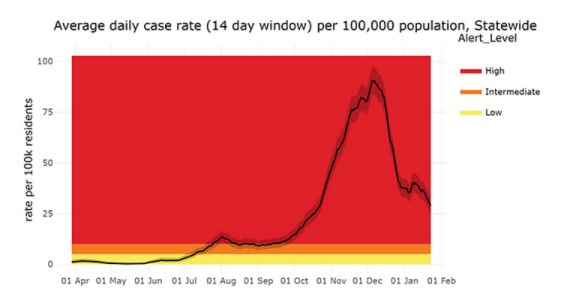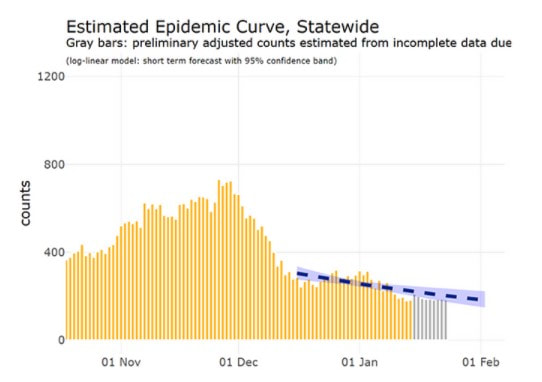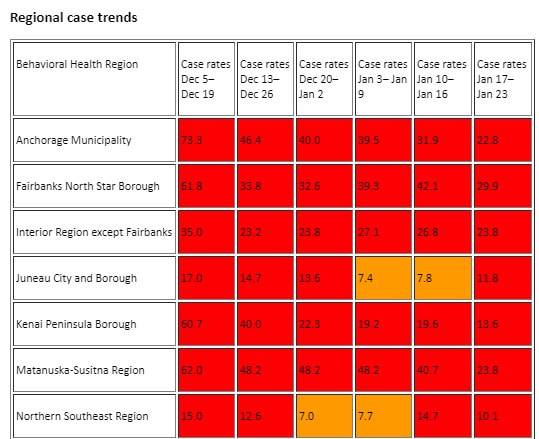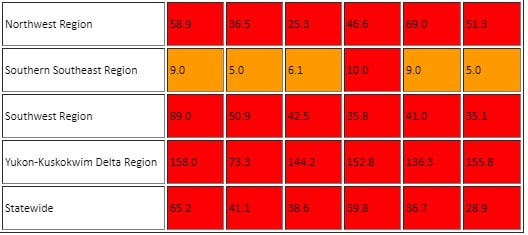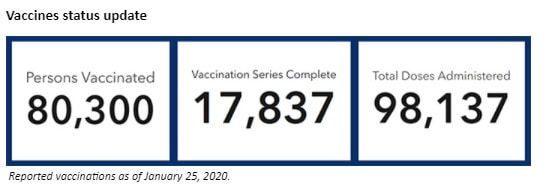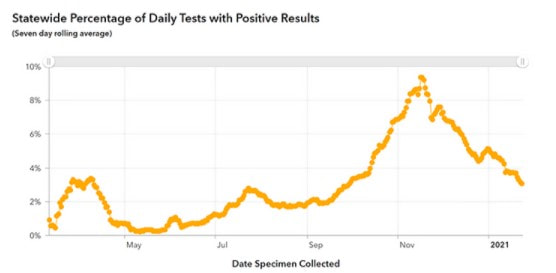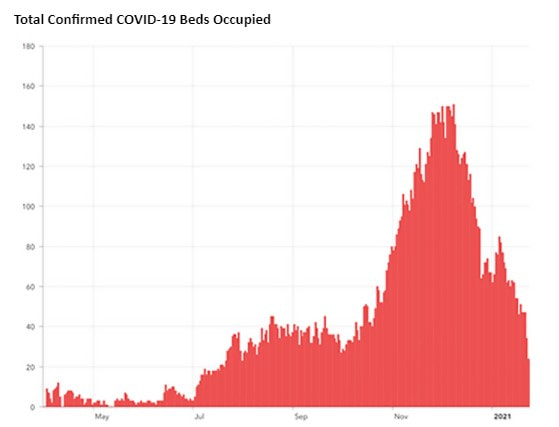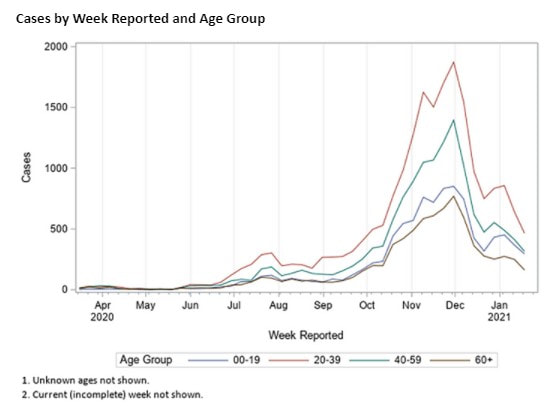Are you looking for a shipping solution? Maybe you need to change freight carriers? Find out what the hard working and reliable people at Team Worldwide can do over land, sea and air
Alaska Department of Health & Social Services Weekly Case Update
January 17 – January 23, 2021
Brief status report
- Virus transmission continues to slowly decrease across most areas of Alaska, although Western Alaska case rates remain high and increasing.
- Vaccination of Alaskans continues, although supply remains the main limiting factor. The February allocation for Alaska is not yet known.
- Alaska is currently the most vaccinated state per capita and in one ranking is the safest state in the US during COVID-19.
- Alaskans who are 65 and older, healthcare workers or nursing home residents are eligible for vaccination. Other Alaskans may not register for appointments at this time. Alaskans receiving health services through a Tribal Health Organization or the Department of Defense should contact those organizations directly to determine their eligibility.
- Alaska continues to monitor for new variants of concern. One travel-related case of the B.1.1.7 variant, which was first identified in the UK in December and is thought to be more transmissible than other strains, has been found in Alaska.
- Every Alaskan who chooses to wear a mask, stay 6 feet from others, and avoid indoor gatherings helps protect themselves and the health of all Alaskans.
- New virus strains may be more transmissible. Masks, distancing, vaccination, avoiding gatherings, following all travel requirements, and other mitigation measures are our best tools to decrease the chance of the new variant entering Alaska and spreading.
- Alaska Health Order 6 requires, at minimum, a test within 72 hours before arrival and strict social distancing for five days on arrival to Alaska. To stop new strains of virus from coming into Alaska and spreading, testing 1-3 days before travel, staying home for 7 days after travel and testing again 3-5 days after travel as laid out in the new CDC guidelines for international and domestic travel is highly encouraged. As of Jan 26, 2021, the CDC requires international travelers to show proof of a negative test from within the last 72 hours on arrival back in the US. The international test required by the CDC does not necessarily replace the test required for travel to Alaska, and travelers to Alaska are encouraged to be sure to obtain the correct type of test.
- CDC guidelines recommend regular testing for critical infrastructure workers and other groups at higher risk for COVID-19, even if they are asymptomatic. While these recommendations are not requirements for testing, DHSS is available to consult on the logistics of expanding testing.
- Alaskans should get tested immediately at the first sign of any symptoms. Tests work best when obtained promptly after symptoms start. Testing early helps people know if they are positive quickly and helps prompt them to take immediate precautions to minimize the risk of transmitting the virus to others.
- Most Alaskans get COVID-19 from a friend, family member, or coworker. Many Alaskans who are diagnosed with COVID-19 report that they went to social gatherings, community events, church services, and other social venues while they were contagious but before they knew they had the virus.
- Alaskans should avoid indoor gatherings with non-household members, avoid crowds, wear masks when around non-household members, and stay 6 feet from anyone not in their household.
Case trends and predictions
- 1,300 new cases were reported in Alaskans last week. This is a 24% decrease from the week before and still reflects continued high-level community transmission throughout much of Alaska.
- 14-day average daily case rates decreased across many regions of Alaska.
- The largest increase was seen in the Yukon-Kuskokwim Region, from 136.3 to 155.8. A smaller increase was seen in Juneau, from 7.8 to 11.8. All regions of Alaska other than the Southern Southeast Region continue to have high community transmission and are at a high alert level.
- The estimated statewide daily growth rate as of January 25, 2021 is -1.1% and new cases are expected to halve every 64 days based on current modeling, slightly slower than last week.
- The State of Alaska is working with federal, local, Tribal, and military partners to ensure that the distribution of vaccine goes as quickly and smoothly as possible.
- Currently eligible groups for vaccination include those in Phase 1a: healthcare workers and residents in nursing homes, and those in Phase 1b Tier 1, Alaskans aged 65 or older. Other groups in Phase 1b may not register at this time but may register as soon as vaccination opens for their phase and tier. All registration for vaccines should go through the registration system on covidvax.alaska.gov , which also has an eligibility tool for any Alaskan unsure of when they can receive the vaccine. All updates on phases and tiers will be posted on that website and new appointments are added on a continuous basis; Alaskans are encouraged to check it frequently.
- The State of Alaska vaccine allocation of 78,000 does not include Tribal or military allocations, which are separate. The IHS allocation is tracked on the dashboard, which also notes vaccinations by behavioral health region.
- A limited amount of vaccine is currently available with more expected to be delivered in the coming months. As of January 23rd, more than 80,000 Alaskans had received at least one COVID-19 vaccine and more than 17,000 had received both doses. On January 18, the New York Times vaccination tracker had Alaska second only to West Virginia for percent of residents vaccinated. The Alaska vaccine tracker is available online as is a vaccine dashboard for more up-to-date data.
- There is a several day lag in reporting some vaccinations so the dashboard does not yet reflect all vaccinations that have been given. All vaccines allocated to Alaska for December and January have been distributed or are otherwise intended for a specific appointment within the month of January.
- There are no plans to mandate a vaccine at the state level.
- The national Advisory Committee on Immunization Practices (ACIP) is responsible for providing national recommendations for vaccine administration and allocation.
- During the week of January 17 through January 23, 2021, 1,300 new Alaska cases were reported, a 24% decrease from last week, for a total of 51,610 cumulative cases in Alaskans.
- Cumulative hospitalizations increased to 1,161 with 10 reported as occurring this week. Hospitalization reports often lag and only 1,130 hospitalizations were reported at this time last week, so there are 31 hospitalizations newly reported this week including ones that began during previous weeks.
- Deaths among Alaska residents increased by 29 (257 total). All deaths occurred prior to this past week. It is common to take more than a week for a death to be reported, and more deaths that occurred during Jan 17–Jan 23 may be reported in future as death certificates are reviewed.
- 48 new nonresident cases were identified this week, for a total of 1,642 cases.
Health care capacity
- On January 25, 42 Alaskans with confirmed COVID-19 were hospitalized and 7 were reported to have required a mechanical ventilator.
- Hospital staffing can change quickly, particularly if a community has many health workers impacted by COVID-19.
Additional informational resources:
- The State of Alaska COVID-19 vaccine status update page.
- The State of Alaska COVID-19 information page provides more information about the virus and how individuals and businesses can protect themselves and others from transmission.
- For the most up-to-date case information, see the Alaska Coronavirus Response Hub dashboard (note: some data may change as more information comes to light through contact tracing and other public health work).
- For DHSS media inquiries, please contact [email protected]

